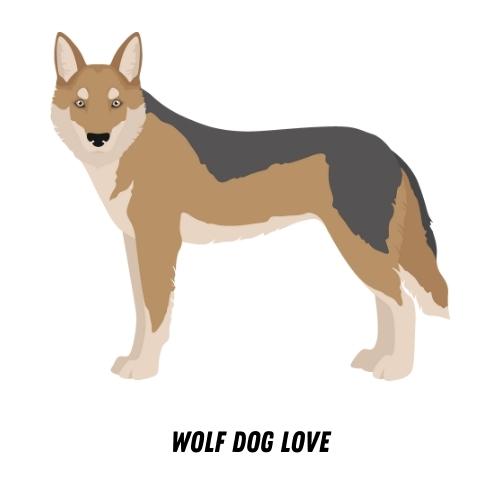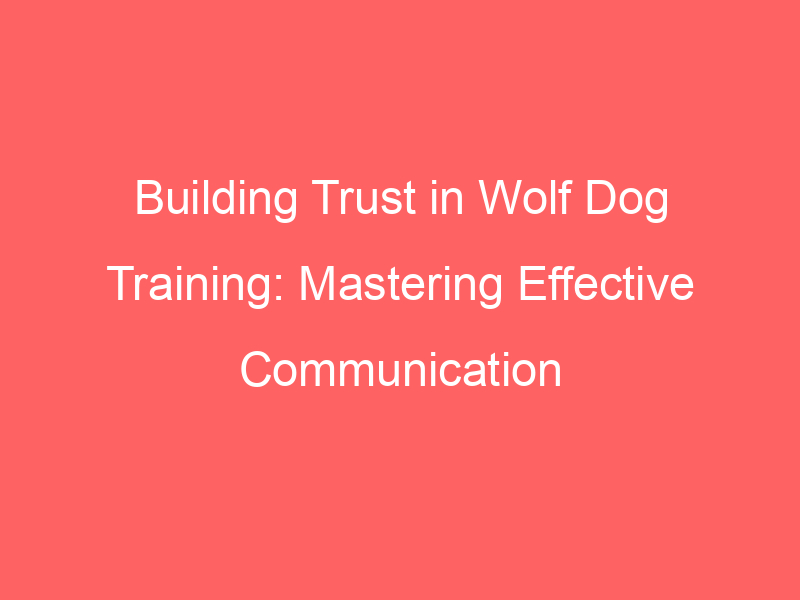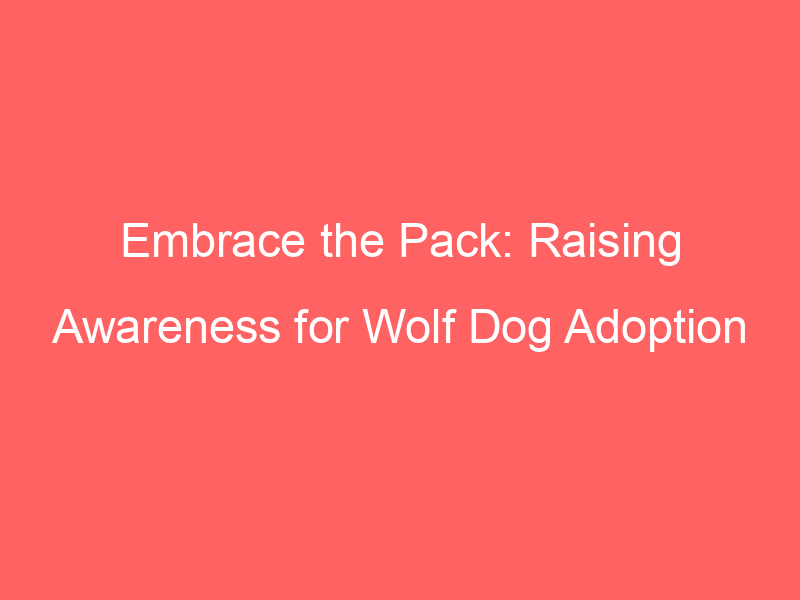Introduction to Wolf Dog Training
Wolf dogs, a unique blend of domestic dog and wild wolf, are fascinating creatures. Training these special animals requires a deep understanding of their unique needs and behaviors. This article will guide you through the process, highlighting the importance of trust and effective communication in wolf dog training.
-
Understanding the Unique Challenges of Wolf Dog Training
Training a wolf dog is not like training a regular dog. Wolf dogs have a strong instinctual behavior that is deeply rooted in their wolf heritage. They are intelligent, independent, and can be stubborn at times. This means that traditional dog training methods may not always work on them. Instead, training a wolf dog requires patience, understanding, and a tailored approach that respects their unique nature.
-
Importance of Trust in Dog Training
Trust is the cornerstone of any successful dog training program, but it is especially important when training wolf dogs. These animals are naturally wary and can be suspicious of humans. Building trust with your wolf dog is crucial. It helps to establish a positive relationship, making training more effective. Trust is built over time through consistent, positive interactions. Remember, it’s not about dominating your wolf dog, but about building a relationship based on mutual respect and understanding.
-
The Role of Effective Communication with Dogs
Communication is key in any relationship, and the one between you and your wolf dog is no exception. Effective communication involves understanding your wolf dog’s body language and vocalizations, and responding in a way that they understand. This two-way communication helps to build trust and makes training more effective. Remember, it’s not about commanding your wolf dog, but about communicating your expectations clearly and consistently.
In the following sections, we will delve deeper into understanding wolf dog behavior, building trust, and effective communication in dog training. We will also share some practical wolf dog training tips and success stories to inspire and guide you on your journey.
Understanding Wolf Dog Behavior
Wolf dogs, a unique blend of domestic dog and wild wolf, exhibit a fascinating array of behaviors. Understanding these behaviors is crucial for effective training. Let’s delve into the common traits and behaviors of wolf dogs and how this understanding aids in training.
- Common traits and behaviors of wolf dogs
Wolf dogs are known for their intelligence, independence, and strong pack mentality. They are often more curious, active, and exploratory than many other dog breeds. Here are some common behaviors:
- High energy levels: Wolf dogs are naturally energetic and require plenty of physical and mental stimulation.
- Strong prey drive: Due to their wolf heritage, these dogs may have a strong instinct to hunt.
- Pack mentality: Wolf dogs are social animals that thrive in a pack environment. They often form strong bonds with their human family, viewing them as their pack.
- Intelligence: These dogs are highly intelligent and can be quick learners. However, their independent nature can sometimes make training a challenge.
- How understanding Wolf Dog Behavior aids in training
Understanding the behaviors and traits of wolf dogs can greatly aid in training. Here’s how:
- Energy management: Knowing that wolf dogs are high-energy animals, incorporating plenty of exercise into their daily routine can help keep them calm and focused during training sessions.
- Prey drive: Understanding their strong prey drive can help in developing training methods that utilize this instinct in a positive way, such as fetch or tracking games.
- Pack mentality: Recognizing their pack mentality can help in establishing a leadership role, which is crucial for successful training.
- Intelligence: Their intelligence can be harnessed for training by using complex commands and puzzles to keep them engaged and challenged.
In conclusion, understanding the unique behaviors and traits of wolf dogs is a key step in effective training. By respecting their nature and working with their instincts, we can build a strong bond and ensure a successful training journey.
Building Trust with Wolf Dogs
Building trust with a wolf dog is a crucial step in establishing a healthy and long-lasting relationship. This process requires patience, understanding, and a strong foundation.
Establishing a Strong Foundation
Before we delve into the specifics, it’s essential to understand that a strong foundation is the cornerstone of any successful relationship with a wolf dog. This foundation is built on two key elements:
- The Importance of Consistency in Fostering Trust
- Building a Safe and Comfortable Environment
Consistency is key when it comes to building trust with a wolf dog. These animals are highly intelligent and can quickly pick up on inconsistencies in your behavior. For instance, if you reward a wolf dog for a specific behavior one day and then punish it for the same behavior the next, it will become confused and may start to distrust you. Therefore, it’s crucial to be consistent in your actions and responses.
Wolf dogs need to feel safe and comfortable in their environment to trust you. This means providing them with a clean, spacious living area, plenty of exercise, and a balanced diet. It also involves protecting them from potential threats and ensuring they have a quiet place to retreat to when they feel overwhelmed.
By focusing on these two elements, you can establish a strong foundation that will make it easier to build trust with your wolf dog. Remember, trust isn’t built in a day; it’s a gradual process that requires patience and consistency.
Building Trust through Training Techniques
Training your wolf dog requires a unique approach that combines understanding, patience, and positive reinforcement. These techniques are not just about teaching commands, but also about building a strong bond of trust between you and your pet.
- Role of Positive Reinforcement in Building Trust
Positive reinforcement is a powerful tool in dog training, especially when it comes to wolf dogs. When your pet follows a command or behaves in a desired way, rewarding them with a treat, praise, or a favorite toy encourages them to repeat that behavior. This approach not only makes the training process enjoyable for your wolf dog but also strengthens your bond with them.
According to a study by the American Veterinary Society of Animal Behavior, positive reinforcement techniques lead to better results in dog training and help to build a stronger relationship between the pet and the owner. This method is particularly effective in training wolf dogs, who are naturally intelligent and responsive to positive interactions.
- Importance of Patience and Understanding in Training Techniques for Wolf Dogs
Training a wolf dog requires a lot of patience and understanding. Unlike other breeds, wolf dogs have a strong instinctual behavior that can sometimes make training a challenge. However, with patience and understanding, you can effectively communicate your expectations to your pet.
Remember, it’s not about forcing your wolf dog to obey commands, but about teaching them in a way that respects their unique nature. It’s important to understand that progress might be slow, but every small step is a significant milestone in building trust.
Patience and understanding in training not only help in teaching new commands but also play a crucial role in correcting unwanted behaviors. Instead of punishing your wolf dog for a mistake, guide them towards the right behavior. This approach helps to build trust and makes your pet more willing to learn.
In conclusion, building trust with your wolf dog through training techniques involves a combination of positive reinforcement, patience, and understanding. Remember, the goal is not just to train but to build a strong and trusting relationship with your pet.
Effective Communication in Dog Training
Communication is the cornerstone of any successful relationship, including the one between you and your wolf dog. Understanding how to communicate effectively with your dog can make the training process smoother and more enjoyable for both of you.
Verbal and Non-Verbal Communication
When it comes to dog training, both verbal and non-verbal communication play significant roles. Let’s delve into these two aspects:
- Understanding the Importance of Tone and Body Language
- How to Use Verbal Commands Effectively
- Keep it Simple: Use short, simple commands like “Sit,” “Stay,” or “Come.” These are easier for your dog to understand.
- Be Consistent: Always use the same words for each command. Changing the command can confuse your dog and hinder the training process.
- Use a Firm, but Gentle Tone: A firm tone can convey authority, but it’s essential to ensure it doesn’t sound threatening or scary to your dog.
Just like humans, dogs are very sensitive to tone and body language. They can pick up on subtle changes in your voice and posture, which can influence their behavior. For instance, a stern tone can signal disapproval, while a relaxed posture can convey that there’s no threat.
When training your wolf dog, it’s crucial to maintain a consistent tone and body language. This consistency helps your dog understand what you expect from them, making the training process more effective.
Verbal commands are a vital part of dog training. However, it’s not just about what you say, but how you say it. Here are some tips to use verbal commands effectively:
Remember, effective communication in dog training is a two-way street. It’s about understanding your dog’s signals and responding in a way they can understand. With patience and consistency, you can build a strong, trusting relationship with your wolf dog.
Understanding Your Dog’s Communication
Effective communication is key to building a strong bond with your wolf dog. This involves not only expressing your commands clearly but also understanding your dog’s unique ways of communicating. Let’s delve into this further.
- Interpreting your dog’s body language and vocalizations
- Responding appropriately to your dog’s communication
Just like humans, dogs have a language of their own. They use a combination of body language, vocalizations, and facial expressions to express their feelings and intentions. For instance, a wagging tail often signifies happiness, while a growl might indicate fear or aggression. Understanding these signals can greatly enhance your relationship with your dog.
Consider this: If your dog’s ears are pinned back and the tail is tucked between the legs, it’s likely that your dog is feeling scared or anxious. On the other hand, if the dog’s ears are pricked up and the tail is wagging, it’s probably excited or happy.
Vocalizations like barking, growling, or whining also carry important messages. A high-pitched bark might mean your dog is excited or anxious, while a low growl could be a warning sign of aggression. Remember, every dog is unique, so these signals might vary slightly. The key is to observe and understand your dog’s specific communication style.
Once you understand your dog’s communication, the next step is to respond appropriately. This involves acknowledging your dog’s feelings and reacting in a way that reinforces positive behavior and discourages negative behavior.
For example, if your dog is showing signs of fear or anxiety, it’s important to reassure it with a calm and soothing voice. On the other hand, if your dog is displaying signs of aggression, it’s crucial to maintain a firm and assertive stance without resorting to punishment or aggression yourself.
Remember, your response to your dog’s communication plays a crucial role in shaping its behavior. By responding appropriately, you can build a strong bond of trust and understanding with your dog, making training more effective and enjoyable for both of you.
In conclusion, understanding and responding to your dog’s communication is a vital part of effective dog training. It not only helps in building a strong bond with your dog but also makes the training process smoother and more effective. So, take the time to observe your dog, understand its unique language, and respond appropriately. Your dog will thank you for it!
Wolf Dog Training Tips
Training a wolf dog is a unique experience that requires patience, understanding, and the right techniques. Here are some practical tips and common mistakes to avoid to make the process more successful and enjoyable for both you and your wolf dog.
-
Practical tips for successful wolf dog training
Understanding your wolf dog’s behavior is the first step towards successful training. Here are some practical tips:
- Start training early: The best time to start training your wolf dog is when they are a puppy. This is when they are most receptive to learning new things.
- Use positive reinforcement: Reward your wolf dog for good behavior. This could be in the form of treats, praise, or extra playtime. This will encourage them to repeat the behavior in the future.
- Be consistent: Consistency is key in dog training. Use the same commands and rewards to avoid confusing your wolf dog.
- Patience is crucial: Wolf dogs are intelligent but can be stubborn. Be patient and persistent in your training efforts.
-
Common mistakes to avoid in Wolf Dog Training
While training your wolf dog, it’s important to avoid these common mistakes:
- Neglecting socialization: Wolf dogs need to be socialized from a young age to ensure they are comfortable around other animals and people.
- Using negative reinforcement: Punishing your wolf dog for bad behavior can lead to fear and aggression. Instead, focus on rewarding good behavior.
- Expecting quick results: Training takes time and patience. Don’t expect your wolf dog to learn everything overnight.
- Not being consistent: Changing commands or rewards can confuse your wolf dog and hinder their learning process.
In conclusion, training a wolf dog requires a unique approach. By following these tips and avoiding common mistakes, you can build a strong, trusting relationship with your wolf dog and enjoy a rewarding training experience.
Case Studies: Success Stories in Building Trust with Wolf Dogs
Let’s delve into some real-life examples of successful wolf dog training. These case studies will illustrate the techniques used and the key takeaways that can help you in your journey of building trust with your wolf dog.
- Example 1: The Story of Max
Max, a wolf dog, was initially very wary of humans. His trainer, Sarah, used a technique called positive reinforcement. This involved rewarding Max with treats and praise whenever he showed trust or obeyed a command. Over time, Max began to associate Sarah with positive experiences, leading to a strong bond of trust.
Key Takeaway: Positive reinforcement can be a powerful tool in building trust with a wolf dog.
- Example 2: The Journey of Bella
Bella, another wolf dog, was initially very aggressive. Her trainer, John, used a technique called desensitization. This involved gradually exposing Bella to things she feared or disliked, in a controlled and calm manner. Over time, Bella’s fear and aggression reduced significantly.
Key Takeaway: Desensitization can help reduce fear and aggression in wolf dogs, paving the way for trust.
- Example 3: The Transformation of Rocky
Rocky, a wolf dog, was very aloof and unresponsive to commands. His trainer, Lisa, used a technique called clicker training. This involved using a device that made a distinct ‘click’ sound whenever Rocky obeyed a command. The ‘click’ was always followed by a treat, helping Rocky understand that obeying commands led to rewards.
Key Takeaway: Clicker training can be an effective method to communicate with and train wolf dogs.
These case studies highlight the importance of patience, understanding, and the right training techniques in building trust with wolf dogs. Remember, every wolf dog is unique and what works for one might not work for another. It’s all about finding what works best for your wolf dog and sticking with it.
Conclusion: The Journey towards Trust and Effective Communication
In our exploration of wolf dog training, we have journeyed through understanding wolf dog behavior, building trust, and establishing effective communication. Let’s take a moment to recap and reflect on the importance of these elements in the training process.
- Recap of the importance of trust and communication in wolf dog training
- Encouragement for continued patience and consistency in training
Trust is the cornerstone of any successful wolf dog training program. Without trust, our efforts to train and communicate with our wolf dogs will likely fall on deaf ears. Trust is built over time, through consistent and positive interactions. It’s about showing your wolf dog that you are a reliable and safe presence in their life.
Communication, on the other hand, is about understanding and being understood. It’s about learning to speak your wolf dog’s language and teaching them to understand yours. Effective communication in dog training involves using clear, consistent commands and signals, and rewarding your wolf dog for correct responses.
Wolf dog training is not a one-time event, but a lifelong journey. It requires patience, consistency, and a deep understanding of your wolf dog’s unique needs and behaviors. There will be challenges along the way, but remember, every step you take towards building trust and effective communication is a step towards a stronger, more rewarding relationship with your wolf dog.
So, keep going. Stay patient. Stay consistent. And remember, the journey towards trust and effective communication is just as important as the destination. Happy training!








